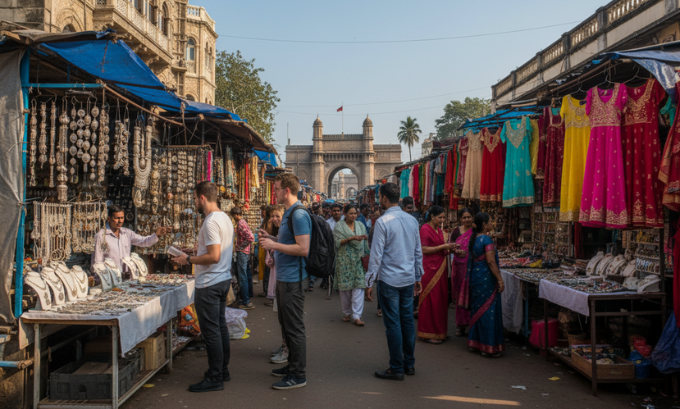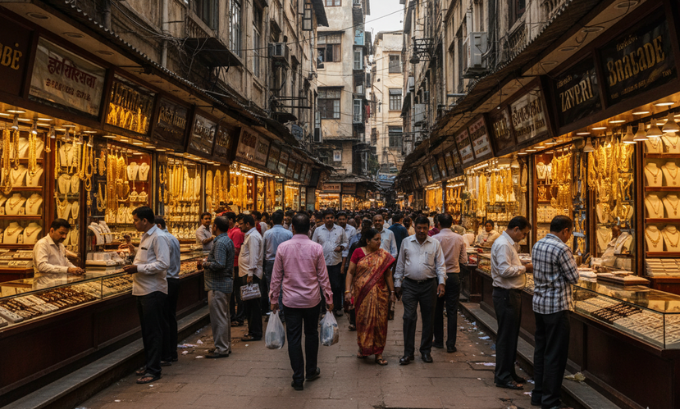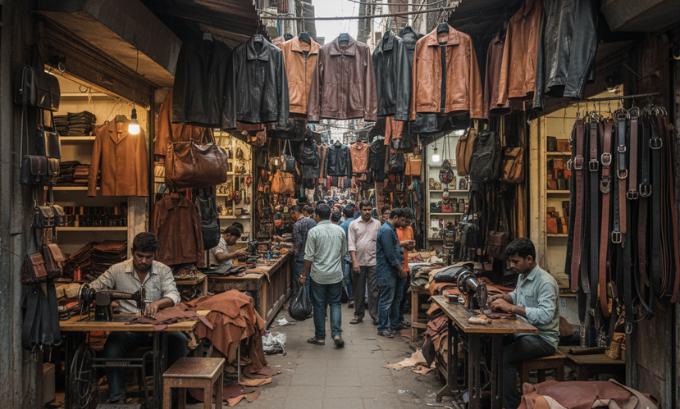Mumbai isn’t just India’s financial capital—it’s a shopper’s paradise where centuries-old bazaars sit alongside glittering malls. Whether you’re hunting for vintage Bollywood posters in Chor Bazaar or browsing designer labels at Palladium Mall, this city offers shopping experiences that cater to every taste and budget.
This guide takes you through most iconic destinations of Shopping Markets in Mumbai, from the spice-scented lanes of Crawford Market to the leather workshops of Dharavi. You’ll discover where to find the best deals, what to buy, and how to navigate each market like a local.
Table of Contents
Mumbai’s Street Shopping Scene: Where Tradition Meets Commerce
Mumbai’s street markets are the beating heart of the city’s shopping culture. These bustling bazaars have served locals and visitors for generations, offering everything from fresh produce to exquisite jewelry. The experience of shopping in these markets goes beyond mere transactions—it’s about bargaining, discovering hidden gems, and immersing yourself in Mumbai’s vibrant street life.
Colaba Causeway: Tourist Central with Local Charm
Colaba Causeway ranks among Mumbai’s most popular shopping destinations, especially for tourists. This historic street stretches from Regal Cinema to the Gateway of India, lined with street vendors and small shops selling souvenirs, accessories, and clothing.

What to buy: Embroidered bags, vintage jewelry, antique brass items, leather goods, and quirky t-shirts featuring Mumbai landmarks.
Shopping tips: Start your bargaining at 40% of the quoted price. Most vendors expect negotiation. The street comes alive in the evening when the crowds thin slightly, making it easier to browse. For those interested in exploring more about Mumbai’s cultural landmarks, you might want to learn about India’s southernmost point.
Best time to visit: Weekday evenings (5 PM – 9 PM) offer the best balance of selection and manageable crowds.
Crawford Market: Mumbai’s Historic Food and Flower Hub
Built in 1869, Crawford Market (officially Mahatma Jyotiba Phule Market) is an architectural marvel that houses one of Mumbai’s largest wholesale and retail markets. The Gothic-style building features beautiful stained glass windows and intricate stone carvings.
What to buy: Fresh spices, dry fruits, exotic fruits, fresh flowers, poultry, and home essentials. The spice section is particularly impressive, with vendors offering everything from Kashmir saffron to Goan kokum.
Insider tip: Visit early morning (7 AM – 10 AM) when the produce is freshest and prices are most negotiable. Bring a reusable bag as plastic bags aren’t always available.
For more insights on building successful shopping strategies, consider reading about goal-setting techniques that can help you plan your shopping trips more effectively.
Zaveri Bazaar: Mumbai’s Glittering Gold Hub
Located in the heart of South Mumbai, Zaveri Bazaar is one of India’s oldest jewelry markets. This wholesale hub specializes in gold, silver, diamond, and platinum jewelry, attracting buyers from across the country.

What to buy: Traditional gold jewelry, diamond pieces, silver utensils, and custom-designed ornaments. Many shops offer making charges as low as 5-10% for bulk purchases.
Important considerations: Always check for hallmarking on gold jewelry (BIS certification). Reputable shops will provide proper bills and certificates. For bridal shopping, visit during Diwali or Akshaya Tritiya for festival discounts.
Bargaining scope: Limited on gold prices (as they’re based on daily rates), but making charges are negotiable.
Wholesale Markets: Shop Like a Local
Dharavi Leather Market: Quality Beyond Stereotypes
Dharavi, while known as one of Asia’s largest informal settlements, houses thriving industries including a robust leather goods market. The quality and affordability of products here surprise many first-time visitors.

What to buy: Leather bags, wallets, belts, shoes, and jackets. Many workshops accept custom orders and can create pieces based on your specifications.
Shopping experience: Most workshops welcome visitors to see the craftsmanship firsthand. Prices are typically 30-50% lower than retail stores. However, returns and exchanges are difficult, so inspect items carefully before purchasing.
How to navigate: Hiring a local guide can help you find the best workshops and negotiate prices. Many workshops now accept digital payments, making transactions smoother.
Mangaldas Market: Textile Treasure Trove
This wholesale fabric market in Kalbadevi is a paradise for those looking for traditional Indian textiles. From silk sarees to dress materials, the variety is staggering.
What to buy: Silk fabrics, cotton dress materials, embroidered borders (laces), sequined fabrics, and traditional wedding textiles. Minimum purchase requirements vary by shop, but many vendors sell smaller quantities to individual buyers.
Best deals: Visit during festival seasons (pre-Diwali, pre-wedding season) when vendors offer bulk discounts to clear inventory.
For those interested in exploring consumer trends beyond Mumbai, you might find articles about the Consumer Electronics Show 2025 fascinating, as they offer insights into global shopping patterns.
Bhuleshwar Market: Traditional Clothing Central
Adjacent to Mangaldas Market, Bhuleshwar specializes in traditional Indian clothing. This is where Mumbaikars shop for festival and wedding attire.
What to buy: Ready-made sarees, lehengas, salwar kameez sets, and traditional accessories. The market also has a thriving section for artificial jewelry that looks remarkably authentic.
Bargaining strategy: Shopkeepers expect at least 20-30% negotiation on marked prices. Buying multiple items from one shop typically yields better discounts.
Street Shopping Favorites: Fashion on a Budget
Linking Road and Hill Road: Bandra’s Fashion Streets
These parallel roads in Bandra West are shopping destinations for affordable, trendy clothing. College students and young professionals flock here for Western wear, accessories, and footwear.

What to buy: Dresses, tops, jeans, sunglasses, bags, and footwear. Quality varies, so inspect items carefully. Many stalls sell export surplus and overstock from branded stores.
Shopping hours: Shops open around 11 AM, but the best time to visit is 4 PM – 9 PM when all vendors are set up and the evening breeze makes browsing more comfortable.
Parking and access: Finding parking can be challenging on weekends. Consider using public transport or ride-sharing services.
Fashion Street: South Mumbai’s Bargain Boulevard
Near Azad Maidan, Fashion Street offers one of Mumbai’s most extensive collections of affordable clothing. This street market operates from morning until late evening.
What to buy: T-shirts, jeans, Western wear, gym clothes, and basic accessories. Quality is mixed—some items are genuine export surplus while others are local imitations.
Price range: T-shirts start at ₹100-150, jeans at ₹300-500, and dresses at ₹400-800. Always bargain, starting at half the quoted price.
Specialty Markets Worth Exploring
Chor Bazaar: Mumbai’s Antique Paradise
“Thieves Market” earned its name from urban legend, but today it’s a legitimate antique market where collectors find rare treasures. Located in the Mutton Street area, it’s famous for vintage items and Bollywood memorabilia.

What to buy: Vintage cameras, old coins, Bollywood posters, antique furniture, gramophone records, and colonial-era artifacts. Authentication can be tricky, so bring someone knowledgeable if making expensive purchases.
Shopping wisdom: Many items are reproductions rather than genuine antiques. Bargaining is essential—start at 50% of the asking price. For unique finds, visit on Fridays when the market is most active.
For insights into global market trends, you might explore articles about international developments like the Middle East crisis, which can affect global commerce.
Lalbaug Spice Market: Aromatic Shopping Experience
While Crawford Market gets more tourist attention, Lalbaug Market offers a more authentic, local spice shopping experience. This wholesale market supplies restaurants and retailers across the city.
What to buy: Whole spices, ground masalas, dry fruits, nuts, and specialty ingredients like saffron and cardamom. Prices are lower than retail stores, especially for bulk purchases.
Quality check: Reputable vendors allow you to smell and sometimes taste samples. Look for vibrant colors in spices—dullness indicates old stock.
Luxury Shopping: Mumbai’s High-End Retail
Palladium Mall: Designer Shopping Destination
Located in Lower Parel, Palladium Mall caters to luxury shoppers with international and Indian designer brands. This mall redefined upscale shopping when it opened, bringing global retail standards to Mumbai.

What you’ll find: International brands like Zara, H&M, and Sephora alongside Indian designers. The mall also houses fine dining restaurants and a premium multiplex.
Special features: Personal shopping services, valet parking, and seasonal fashion shows make this more than just a shopping destination.
Best for: Those seeking authentic branded products, the latest international fashion trends, and a premium shopping experience.
Phoenix Marketcity: Entertainment Meets Shopping
This expansive mall in Kurla combines shopping with entertainment. It’s one of Mumbai’s largest malls, offering everything from fast fashion to electronics.
Shopping variety: Mix of international brands, Indian labels, home décor stores, and a massive electronics section. The mall frequently hosts sales offering 30-50% discounts.
Family-friendly: Features a large gaming zone, multiple food courts, and a multiplex cinema, making it ideal for family outings.
Shopping in Mumbai: Essential Tips
Bargaining Like a Pro
- Start low: Begin negotiations at 40-50% of the asking price in street markets
- Walk away: If the vendor won’t meet your price, walking away often triggers a better offer
- Bundle deals: Buying multiple items from one vendor usually yields better discounts
- Stay friendly: Aggressive bargaining creates tension; keep the interaction pleasant
Best Times to Shop
- Festival seasons: Diwali, Dussehra, and Ganesh Chaturthi bring sales and new inventory
- Wedding season: December to February is prime time for bridal shopping with maximum variety
- End of season: March and September often feature clearance sales in retail stores
- Weekday mornings: Markets are less crowded, and vendors may offer better prices to start their day with sales
Avoiding Fakes and Scams
- Check certification: For jewelry, demand hallmark certificates; for electronics, verify warranty cards
- Sealed packaging: Branded products should have original, sealed packaging
- Test electronics: Always test electronic items before paying
- Receipt matters: Insist on proper bills for all significant purchases
Payment and Safety
- Cash is king: Many street vendors and small shops only accept cash
- Small denominations: Carry small bills as vendors often claim they lack change
- Secure valuables: Keep bags secure and avoid displaying expensive items in crowded markets
- Digital options: Larger shops and malls accept UPI, cards, and mobile wallets
If you’re interested in learning about global shopping innovations and technology, the Consumer Electronics Show articles provide fascinating insights into the future of retail.
What to Buy in Mumbai: Signature Shopping
Traditional Indian Clothing
Mumbai’s markets offer exceptional variety in traditional wear:
- Silk sarees from Mangaldas Market start at ₹2,000 and go up to ₹50,000+
- Embroidered lehengas from Bhuleshwar Market range from ₹5,000-₹75,000
- Cotton kurtis from street markets cost ₹300-₹800
Spices and Dry Fruits
Crawford Market and Lalbaug Market offer premium quality at wholesale prices:
- Kashmir saffron: ₹250-400 per gram
- Dry fruits: Almonds, cashews, and pistachios at 10-20% below retail prices
- Ground masalas: Freshly ground spices at ₹50-150 per 100 grams
Leather Goods
Dharavi’s leather workshops provide excellent value:
- Leather bags: ₹500-3,000 depending on size and quality
- Wallets: ₹200-800
- Custom shoes: ₹1,500-4,000
Jewelry
From fashion jewelry to fine gold:
- Artificial jewelry at Bhuleshwar: ₹100-1,000 per piece
- Silver jewelry at Zaveri Bazaar: Starting from ₹500
- Gold jewelry: Prices based on daily gold rates plus making charges (negotiable)
Mumbai Shopping by Season
Monsoon Shopping (June-September)
The monsoon season brings special shopping considerations. Street markets can be challenging during heavy rains, but malls offer comfortable alternatives. Many vendors offer discounts during this period as foot traffic decreases.
Monsoon specialties: Umbrellas, raincoats, and waterproof bags flood the markets. Crawford Market’s flower section is particularly beautiful as monsoon blooms arrive.
Festival Season (October-November)
Diwali and Durga Puja transform Mumbai into a shopping extravaganza. Markets stock up on new inventory, shops extend hours, and sales are everywhere.
What to shop for: Traditional clothing, gold jewelry (Dhanteras is auspicious for gold purchases), home décor items, and Diwali gifts. Expect crowds but also the year’s best variety.
Wedding Season (December-February)
Mumbai’s wedding season creates a shopping frenzy for bridal wear and accessories.
Where to focus: Mangaldas Market for bridal fabrics, Zaveri Bazaar for wedding jewelry, and Bhuleshwar for ready-made bridal wear. Book custom orders at least 2-3 months in advance.
For those curious about international perspectives on consumer behavior and technology, articles about initiatives like Japan’s visa updates offer interesting cross-cultural comparisons.
Transportation and Logistics
Getting to Markets
Local trains: The most economical option. Crawford Market (CST station), Zaveri Bazaar (Kalbadevi station), and Linking Road (Bandra station) are all well-connected.
Auto-rickshaws: Available in suburbs; negotiate fares beforehand or insist on meters.
App-based cabs: Uber and Ola provide convenient, trackable rides.
Private vehicle: Parking is limited and expensive near popular markets. Malls offer better parking facilities.
Shipping Options
For visitors who shop extensively, several options exist:
Courier services: Blue Dart and DTDC offer domestic and international shipping from Mumbai. Many markets have courier offices nearby.
Airport facilities: Mumbai Airport has packaging and shipping services for last-minute purchases.
Hotel concierge: Many hotels offer packing and shipping assistance for guests.
Frequently Asked Questions
Q: Are Mumbai’s street markets safe for tourists?
A: Yes, generally safe during daylight hours. Stay alert for pickpockets in crowded areas, don’t carry excessive cash, and keep valuables secured. Colaba Causeway and Linking Road are particularly tourist-friendly.
Q: Can I use credit cards at street markets?
A: Most street vendors only accept cash. Some larger shops in markets like Zaveri Bazaar accept cards, but carrying cash (including small denominations) is essential.
Q: How much should I budget for a shopping day in Mumbai?
A: Street market shopping: ₹3,000-10,000 can yield significant purchases. Luxury mall shopping: ₹10,000-50,000+ depending on brands. Always carry extra cash for transportation and refreshments.
Q: Is bargaining acceptable everywhere?
A: Bargaining is expected at street markets and small shops but not at branded stores or malls with fixed prices. In markets, starting at 40-50% of the quoted price is standard practice.
Q: What’s the best area for wholesale shopping?
A: Mangaldas Market (textiles), Crawford Market (food items), Dharavi (leather goods), and Lalbaug (spices) offer wholesale prices with varying minimum purchase requirements.
Q: Are there any shopping etiquette rules I should know?
A: Remove shoes before entering some traditional shops, handle merchandise carefully, and negotiate respectfully. Photography may require permission in some stores, especially in Zaveri Bazaar.
Q: When are the best sales in Mumbai?
A: Major sales occur during Diwali (October-November), Republic Day (January), and Independence Day (August). End-of-season sales happen in March and September at malls and branded stores.
Your Mumbai Shopping Adventure Awaits
Mumbai’s shopping landscape offers something for everyone, from the budget-conscious bargain hunter to the luxury shopper. The city’s markets tell stories of tradition, craftsmanship, and entrepreneurship that span generations. Whether you’re searching for vintage treasures at Chor Bazaar, negotiating for silk at Mangaldas Market, or browsing designer labels at Palladium Mall, each shopping experience contributes to your Mumbai story.
Remember that the best shopping experiences often come from stepping off the beaten path, engaging with local vendors, and embracing the organized chaos that defines Mumbai’s markets. Pack your patience, wear comfortable shoes, and prepare for sensory overload in the best possible way.
The treasures you’ll discover and the memories you’ll create while navigating Mumbai’s shopping scene will last far longer than any purchase. So grab your shopping bags, charge your phone for photos, and dive into one of the world’s most vibrant retail landscapes.
Happy shopping in Mumbai—where every transaction is an adventure and every market tells a thousand stories!


